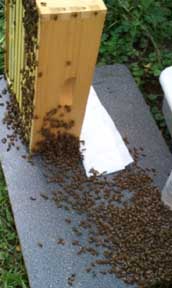Here is why we need pollinators. We had the best ever raspberry crop this year, thanks to the flower by flower work of the new bees:
To get native pollinators you need native plants. It will be sad to lose daffodil, tulip, lily of the valley, forsythia and perhaps even lilac, in return for wild bergamot, anis hyssop, rattlesnake master, mint, grape vine anemone, bee balm, black eyed susan, milkweed, trillium and wild lupine. The work has barely started and already the garden is a jungle of wild insects.
Here is the most exotic one I hope to lure in. It is an enormous cecropia moth, in full daylight, downtown on a native locust tree. It was larger than the palm of my hand:
And here is what 150 pounds (68 kg) kg of honey from one well fed bee hive in just 4 months, looks like:
Native plants grow best in their own locale, but unfortunately native animals like to eat them too.



















